Dynamic Pricing: Functional Examples
Be inspired to use Dynamic Pricing to increase your Revenues with ease.
Summary:
Campspot's Dynamic Pricing feature enables strategic rate adjustments based on occupancy and booking time, offering a versatile tool for revenue optimization. With a potential revenue boost of 191%, this rule proves highly effective in maximizing income. Use this article to view four use cases of this feature to inspire your Revenue Strategy.
Unlocking Revenue Strategies with Dynamic Pricing: Four Practical Examples
Enhance your understanding of Dynamic Pricing by exploring real-world examples that illustrate its versatile application for revenue optimization. Each example provides a unique strategy and includes a user-friendly screenshot of the New Variation form in Campspot.
- Example 1: Increase rates for the entire year
- Example 2: Increase peak season rates using multiple rules for the same period of time
- Example 3: Decreasing rates to accompany a marketing campaign to create business
- Example 4: Increase a Daily Add-on if the booking is so many days prior to arrival
Example 1
Strategy: Boost all Lodging base prices by 10% for 2024 when occupancy exceeds 60%, expiring on 12/31/2024 and available for booking immediately.

| Rule Name | Save the rule with an easily identifiable name. |
| Active Dates | Create a Date Group for 01/01/24 – 12/31/24, defining the rule's application period. |
| Site Types | Select the relevant Lodging Site Types. |
| Expiration Date | This rule will expire at the end of 2024.** |
| Rate Change | Add a one-time 10% increase to the base rate. |
| If occupancy is 60 to 100% | Trigger the increase once occupancy hits 60% across all Lodging Sites. |
| As calculated among site types: | For this rule, I want to base the occupancy threshold off the performance of all my Lodging Sites so once they collectively reach 60%, the rate will increase for all. |
| And is booked 0 to 999 days prior to arrival. | I want my rates to increase through the end of next year. If I only enter 0 to 365 days, only the next 365 days would be impacted by the rule. 0 to 999 days ensures that my rates change for guests booking through the end of next and an allow me to reuse this rule for future years if I want. |
**NOTE: The Date Group assigned in Active Dates will set the tone for when this rule will apply. Being that this rule is meant to be available for all 2024 stay dates and can be booked anytime through 2024 an expiration date is not necessarily required.
Common FAQ:
Q: What if I want to reuse this same rule in 2025?
It is recommended to create new rules year over year to create consistency. Once your calendar is ready to be opened for 2025 bookings, create a new version of this rule.
Q: Why apply the rule to be “as calculated among site types” for the same Site Types as the Site Types impacted by the rule?
In this campground, each Site Type has different numbers of sites within each. If the rule is based off the most popular Site Type which has 2 sites, the rule will automatically kick in for all sites as soon as both of those sites are booked. For this example, I want to change rates based on the entire Lodging product, but this can be easily changed depending on the strategy.
Example 2
Strategy: Increase rates for peak season: Victoria Day to Labour Day. RV rates to increase 10% once my top performing Site Types reach an occupancy of 50%. Lodging rates to increase by $10 once occupancy has reached 40% for all Lodging and then another $10 for just my top performing cabins when they reach 61% or more.
This example will require the creation of 3 rules:
-
RV Rule: Increase rates by 10% once top-performing Site Types reach 50% occupancy.
-
Lodging Rule 1: Raise rates by $10 when overall Lodging occupancy reaches 40%.
-
Lodging Rule 2: Add another $20 for top-performing cabins when their occupancy surpasses 60%.
RV:
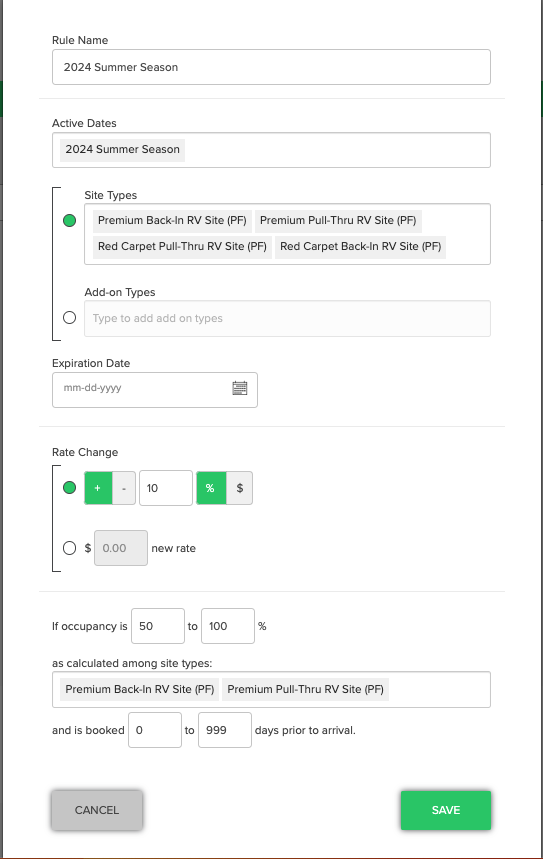
Lodging 1:
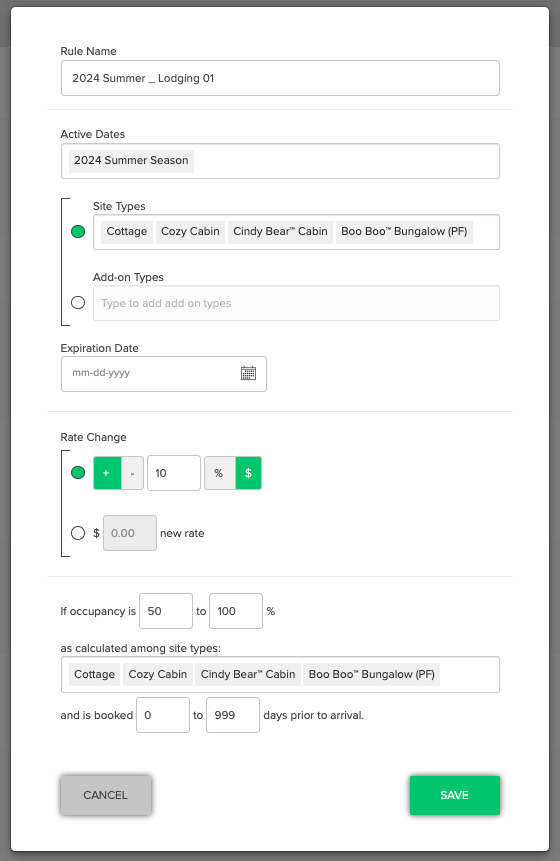
Lodging 2:
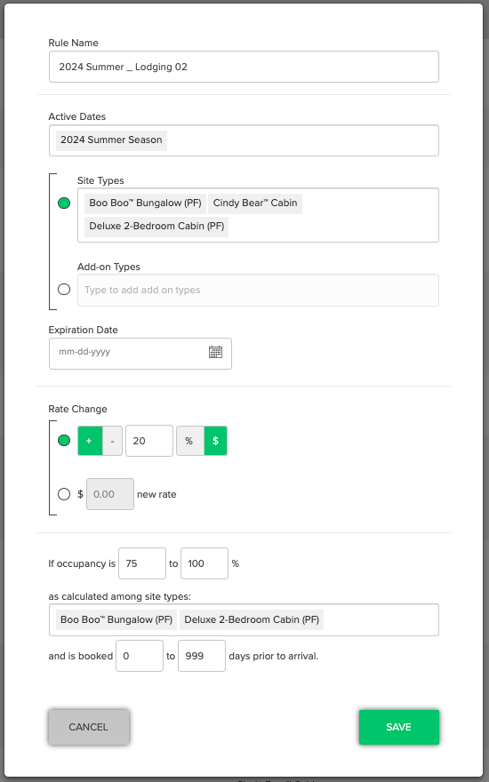
Note on Lodging Rule 2:
You will notice that the dollar amount is $20, not $10. When this rule kicks in, Campspot will not add the rules together so in order to increase by $10 once the Top Lodging sites reach 50% and then again once reaching 75%, this second rule would need to increase the Base rate by $20.
Common FAQ:
Q: What happens if multiple rules overlap each other? (Both Example 1 and Example 2 are active at the same time)
Dynamic rules look at the Date Group to define periods of time. If a reservation qualifies to be defined by more than one Date Group, Campspot will select the more narrow Date Group. In this example, "2024 Summer Season."
Example 3
Strategy: To be very competitive with local campgrounds, offer a flat rate for all RV sites for the Early Winter season if reservation is booking by 12/31/2023 for days of up to 50% occupancy. Tie this to a Marketing Campaign to for my guests to “Escape the dreary winter! Stay with us in any RV site for a flat $60 January – March.”
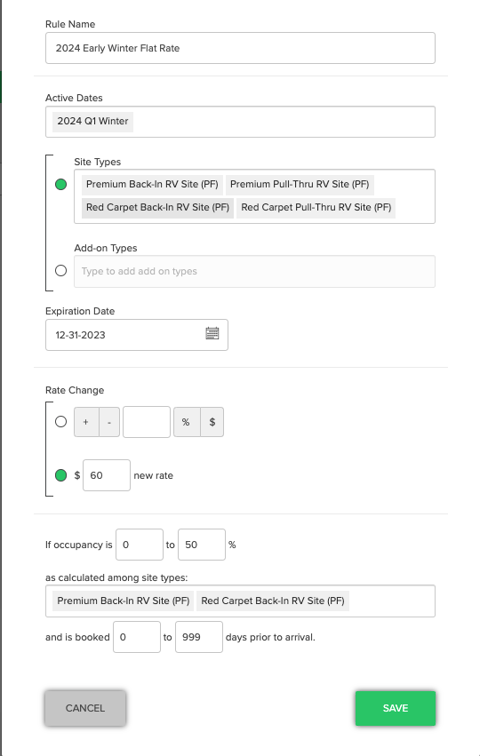
Common FAQ:
Q: Why create a Dynamic Rule for this offer?
This same strategy can be accomplished using Campspot’s Promotion / Discount setup, but I want to publish this rate online, so my guests see it regardless of having received a notification of my lowered rates. When shopping campground to campground, I can grab more market share by publishing my lowered and very competitive rate online.
Example 4
Strategy: My Golf Carts are sold out year over year for the summer months. I want to increase the price of this Add-on by $20 per day once 50% of my golf carts have been reserved and the arrival day is 7 days out.
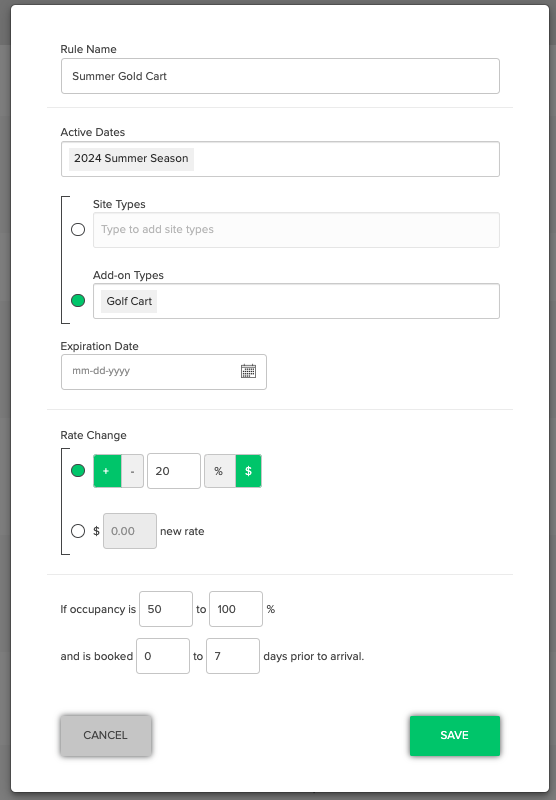
New to Dynamic Pricing in Campspot? Use this article along with the following articles to get the best understanding of how this feature can increase your bottom line!
Dynamic Pricing: Setup New Variation
Common Reporting:
Dynamic Pricing by Site Type
Dynamic Pricing by Reservation
.png?width=200&height=150&name=campspotlogo2019%20(1).png)